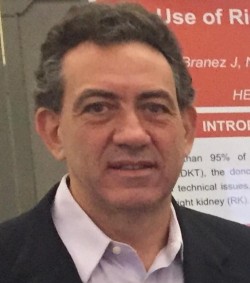
Director of Pancreas and Kidney Transplant Program, Leforte Hospital, Sao Paulo, Brazil
Largest Experience in pancreas transplantation of Latin America with over 1,000 pancreas transplants performed.
Our pancreas transplant program has been one of the most active of the world for the last four years performing from 50-90 PT annualy.
Experience of 91 pancreas retransplants and predictors of outcome
Marcelo Perosa1, Juan Branez1, Fernanda Danziere1, Marcio M. Paredes1, Ana Claudia Vidigal1, Leon Alvim1, Adriana B. Bortoluzzo2, Maria K. Venezuela2, Tercio Genzini1.
1Department of Abdominal Organ Transplantation, Leforte Hospital, São Paulo, Brazil; 2Statistics and Data Science, INSPER Institute of Education and Research, São Paulo, Brazil
Pancreas retransplantation(PRT) activity has declined in recent years mirroring the tendency of overall numbers of pancreas transplantation(PT). This study aimed to analyze our experience with PRT over a 25-year program searching for reliable predictors of outcome.
Donor and recipient characteristics and outcomes data were retrospectively gathered from our databank. An in-depth analysis of PRT and previous PT was performed. Sensitization was considered either if an increase of 20% in cPRA occurred or by appearance of anti-DQs. An induction with Thymoglobulin(7mg/kg) associated to tacrolimus, mycophenolate sodic and steroids was the immunosuppression regimen for all PRT.
From November/2000 to June/2021, 1,018 PT were performed, being 91 PRT(8.9%). Mean donor and recipient ages were 23.7(11-44) and 37.1(22-62) years and cause of donor death was cerebrovascular in 17(18.6%). PRT categories included Re-PAK in 79(87%) and Re-PTA in 12(13%) cases. PRTs were second PT in 83(91%) and third PT in 8(9%). Cause of previous graft loss(CPGL) was technical in 40(44%), immunological in 47(52%) and other in 4(4%). Timing of previous graft loss was early(< 3 months) in 48(53%) and late in 43(47%). The mean time interval from previous PT to PRT was 48.6 months(4-241) being significantly lower whether CPGL was technical compared to immunological(21.8 x 71.6 months, p<0.001). The technical strategy for PRT was a different approach(either for exocrine or venous drainage) in 80 cases(88%) searching for a new and more virgin surgical site. The need of previous graft transplantectomy before or during PRT differed significantly being 100% for technical CPGL and 45% for immunological CPGL(p<0.001). Mean cold ischemia time for PRT was 12.2 hours(7.1-19.1h) and reoperations were required in 21% of the patients.1-year patient survival was similar between PRT and a control cohort of 365 primary solitary PT(91.2% x 92.1%,p=0.83) and also was 1-year pancreas graft survival(69.2% x 72.9%, p=0.51). 1-year patient survival for PRT was also similar according to technical or immunological CPGL(92.5% x 89.4%,p=0.72). There was a tendency of higher pancreas graft survival after PRT for technical vs immunological CPGL(72.5% x 66%, p=0.64). When subcategorized the group with immunological CPGL for early(< 5 years) and late(>5 years) immunological loss, there was a tendency of higher 1-year pancreas graft survival for the latter(84.6%) compared to technical (72.5%) or early immunological CPGL(58.8%, p=0.20).Sensitization after primary PT determined inferior 1-year pancreas graft survival in PRT compared to non-sensitized patients(44.4% x 79.7%, p=0.002).
PRT has achieved similar patient and pancreas graft survivals to primary solitary PT. Early immunological CPGL and sensitization may represent a predictor of inferior outcome after PRT.